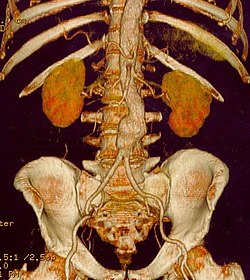| Aortic aneurysm | |
|---|---|
 | |
| Figure A shows a normal aorta. Figure B shows a thoracic aortic aneurysm (which is located behind the heart). Figure C shows an abdominal aortic aneurysm located below the arteries that supply blood to the kidneys. | |
| Specialty | Cardiology, Vascular surgery, Interventional radiology |
| Symptoms | abdominal pain and back pain |
| Complications | Hemorrhaging |
| Diagnostic method | Ultrasound, CT Angiography |
An aortic aneurysm is an enlargement (dilatation) of the aorta to greater than 1.5 times normal size. [1] Typically, there are no symptoms except when the aneurysm dissects or ruptures, which causes sudden, severe pain in the abdomen and lower back. [2] [3]
Contents
- Classification
- Signs and symptoms
- Abdominal aortic aneurysm
- Aortic rupture
- Risk factors
- Pathophysiology
- Prevention
- Screening
- Management
- Medical therapy
- Surgery
- Epidemiology
- See also
- References
- External links
The cause remains an area of active research. Known causes include trauma, infection, and inflammatory disorders. Risk factors include cigarette smoking, heavy alcohol consumption, advanced age, harmful patterns of high cholesterol in the blood, high blood pressure, and coronary artery disease. [4] The pathophysiology of the disease is related to an initial arterial insult causing a cascade of inflammation and extracellular matrix protein breakdown by proteinases leading to arterial wall weakening. [5] They are most commonly located in the abdominal aorta, but can also be located in the thoracic aorta.
Aortic aneurysms result from a weakness in the wall of the aorta and increase the risk of aortic rupture. When rupture occurs, massive internal bleeding results and, unless treated immediately, shock and death can occur. One review stated that up to 81% of people having abdominal aortic aneurysm rupture will die, with 32% dying before reaching a hospital. [6]
According to a review of global data through 2019, the prevalence of abdominal aortic aneurysm worldwide was about 0.9% in people under age 79 years, and is about four times higher in men than in women at any age. [4] Death occurs in about 55-64% of people having rupture of the AAA. [4]
Screening with ultrasound is indicated in those at high risk. Prevention is by decreasing risk factors, such as smoking, and treatment is either by open or endovascular surgery. Aortic aneurysms resulted in about 152,000 deaths worldwide in 2013, up from 100,000 in 1990. [7]



